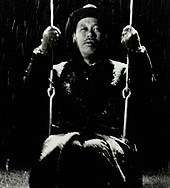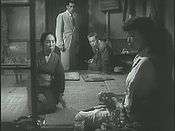Takashi Shimura
| Takashi Shimura | |
|---|---|
|
Shimura in 1956. | |
| Native name | 志村 喬 |
| Born |
島崎 捷爾[1] (Shoji Shimazaki) March 12, 1905 Ikuno, Hyōgo, Japan |
| Died |
February 11, 1982 (aged 76) Tokyo, Japan |
| Cause of death | Emphysema |
| Occupation | Actor |
| Years active | 1934–1981 |
Takashi Shimura (志村 喬 Shimura Takashi, March 12, 1905 – February 11, 1982) was a Japanese actor who appeared in over 200 films between 1934 and 1981. He is particularly noted for his appearances in 21 of Akira Kurosawa's 30 films, including as a lead actor in Drunken Angel (1948), Ikiru (1952) and Seven Samurai (1954).
Early life
Takashi Shimura was born in Ikuno, Hyōgo Prefecture, Japan.[2] His birth-name was Shimazaki Shōji (島崎捷爾). His forebears were members of the samurai class: in 1868 his grandfather took part in the Battle of Toba-Fushimi during the Boshin War. Shimura entered Ikuno Primary School in 1911 and Kobe First Middle School in 1917. He missed two years of schooling because of a mild case of TB, and subsequently moved to the prefectural middle school in Nobeoka, Miyazaki Prefecture, where his father had been transferred by his employer, Mitsubishi Mining. At Nobeoka Middle School, he excelled in English and became active on the literary society's magazine, to which he contributed poetry. He also became a star of the rowing club. In 1923, he entered Kansai University, but after his father's retirement the family could no longer afford the fees for a full-time course and he switched to the part-time evening course in English literature, supporting himself by working at the Osaka municipal waterworks. Among the teachers in the English Literature Department were the playwright Toyo-oka Sa-ichirō (豊岡佐一郎) and the Shakespeare scholar Tsubouchi Shikō (坪内士行). These two inspired in Shimura an enthusiasm for drama. He joined the University's Theatre Studies Society and in 1928 formed an amateur theatrical group, the Shichigatsu-za (七月座) with Toyo-oka as director. He began to miss work because of the time he spent on theatrical activities and eventually lost his job. He then left university to try to earn a living in the theatre. The Shichigatsu-za turned professional and began to tour, but got into financial difficulties and folded.
Career
After the failure of the Shichigatsu-za Shimura went back to Osaka, where he began to get roles in radio plays. In 1930 he joined the Kindaiza (近代座) theatre company and became a fully professional actor. He toured China and Japan with the Kindaiza, but in 1932 he left the company and returned again to Osaka, where he appeared with the Shinseigeki (新声劇) and Shinsenza (新選座) troupes. Talking pictures were just then coming in and Shimura realised they would provide opportunities for stage-trained actors. In 1932 he joined the Kyoto studios of the film production company Shinkō Kinema. He made his film debut in the 1934 silent Ren'ai-gai itchōme (恋愛街一丁目: Number One, Love Street). The first film in which he had a speaking part was the 1935 Chūji uridasu (忠次売出す), directed by Mansaku Itami. His first substantial film role was as a detective in Mizoguchi Kenji's 1936 Osaka Elegy (Naniwa erejii; 浪華悲歌).

The film which established his reputation as a first-rate actor was Itami Mansaku's 1936 Akanishi Kakita (赤西蠣太: Capricious Young Man). In 1937 he moved to Nikkatsu film corporation's Kyoto studios, and between then and 1942 appeared in nearly 100 films. His most notable role in these years was that of Keishirō in the long-running series Umon Torimono-chō (右門捕物帖), starring Kanjūrō Arashi. He also demonstrated his considerable ability as a singer in the 1939 "cine-operetta", Singing Lovebirds. During this time the political regime in Japan was growing ever more oppressive, and Shimura was arrested by the Special Higher Police (Tokubetsu Kōtō Keisatsu, known as Tokkō) and held for about three weeks because of his earlier association with left-wing theatre groups. He was eventually released on the recognisance of his wife Masako and fellow-actor Ryūnosuke Tsukigata. He is said to have made use of this experience later when playing a Tokkō official in Akira Kurosawa's 1946 No Regrets for Our Youth. When Nikkatsu and Daiei merged in 1942, Shimura moved to the Kōa Eiga studios and then in 1943 to Tōhō. A few weeks before the end of the Pacific War in August 1945, Shimura's elder brother was killed in Southeast Asia.
In 1943, Shimura appeared as the old jujutsu teacher Murai Hansuke in Kurosawa's debut movie, Sanshiro Sugata. Along with Toshirō Mifune, Shimura is the actor most closely associated with Kurosawa: he eventually appeared in 21 of Kurosawa's 30 films. In fact, Kurosawa's cinematic collaboration with Shimura, from Sanshiro Sugata in 1943 to Kagemusha in 1980, started earlier and lasted longer than his work with Mifune (1948-65). Shimura's performances for Kurosawa included the doctor in Drunken Angel (1948), the veteran detective in Stray Dog (1949), the flawed lawyer in Scandal (1950), the woodcutter in Rashomon (1950), the mortally ill bureaucrat in Ikiru (1952), and the lead samurai Kambei in Seven Samurai (1954). Kurosawa wrote the part in Kagemusha specifically for Shimura, but the scenes were cut from the Western release, so many in the West did not know that he been in the film. The DVD release of the film by The Criterion Collection restored Shimura's footage.
Shimura appeared in a number of Tōhō monster films and tokusatsu ("special effects") pictures, including the scientist Kyohei Yamane in the first Godzilla and Godzilla Raids Again films.
Death
Shimura died on February 11, 1982 in Tokyo, Japan, from emphysema at the age of 76. His effects were presented to the Film Centre of the National Museum of Modern Art, Tokyo.
Partial filmography

- Number One, Love Street (1934)
- Singing Lovebirds (1939)
- Sanshiro Sugata (1943, Kurosawa)
- The Most Beautiful aka Most Beautifully (1944, Kurosawa)
- The Men Who Tread on the Tiger's Tail (1945, Kurosawa)
- Minshū no Teki (1946)
- No Regrets for Our Youth (1946, Kurosawa)
- Snow Trail (1947)
- Drunken Angel (1948, Kurosawa)
- The Quiet Duel (1949, Kurosawa)
- Stray Dog (1949, Kurosawa) as Detective Sato. Won Best Actor award at 1950 Mainichi Film Concours.
- Boryōku no Machi (1950)
- Scandal (1950, Kurosawa)
- Rashomon (1950, Kurosawa)
- Elegy (1951)
- The Idiot (1951, Kurosawa)
- Ikiru (1952, Kurosawa)
- The Skin of the South (1952)
- Seven Samurai (1954, Kurosawa)
- Godzilla (1954)
- Godzilla Raids Again (1955)
- I Live in Fear aka Record of a Living Being (1955, Kurosawa)
- Samurai III: Duel at Ganryu Island (1956)
- The Mysterians (1957)
- Throne of Blood (1957, Kurosawa)
- Zoku Aoi sanmyaku Shinko no maki (1957)
- The Hidden Fortress (1958, Kurosawa)
- The Loyal 47 Ronin (Chūshingura) (1958)
- Storm Over the Pacific (1960)
- The Bad Sleep Well (1960, Kurosawa)
- Kwaidan (1960, Masaki Kobayashi)
- Yojimbo (1961, Kurosawa)
- Mothra (1961)
- The Story of Osaka Castle (1961) as Katagiri[3]
- Sanjuro (1962, Kurosawa)
- Gorath (1962)
- Chushingura: Hana no Maki, Yuki no Maki (1962)
- High and Low (1963, Kurosawa)
- Ghidorah, the Three-Headed Monster (1964)
- Kwaidan (1964)
- Samurai Assassin (1965)
- Red Beard (1965, Kurosawa)
- Frankenstein Conquers the World (1965)
- Japan's Longest Day (1967)
- Zatoichi and the Fugitives (1968)
- The Sands of Kurobe (1968)
- Zatoichi's Conspiracy (1973)
- Prophecies of Nostradamus (1974)
- Ogin-sama Love and Faith (1978)
- Kagemusha (1980, Kurosawa)
- Story of the Japan Philharmonic: Movement of Flame (1981)
Television
- Akai Unmei
Honours
References
- ↑ http://movie.daum.net/movieperson/Biography.do?personId=50481
- ↑ http://www.allcinema.net/prog/show_p.php?num_p=46229
- ↑ Stuart Galbraith IV (16 May 2008). The Toho Studios Story: A History and Complete Filmography. Scarecrow Press. p. 177. ISBN 978-1-4616-7374-3.
External links
| Wikimedia Commons has media related to Takashi Shimura. |
- Takashi Shimura at the Internet Movie Database
- Takashi Shimura at AllMovie
- Takashi Shimura at the Japanese Movie Database (Japanese)
|